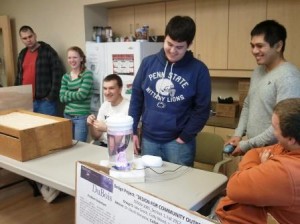By Steve Harmic, Penn State DuBois

DUBOIS – Thanks to a group of freshman engineering students at Penn State DuBois, some area dementia patients are finding comfort in spite of their illness. The students recently applied their engineering know-how to create devices that stimulate the minds of those suffering from Alzheimer’s Disease and other forms of dementia, and those devices are now being used daily at Christ the King Manor Nursing Home in DuBois.
The items, entirely designed and built by the engineering students, vary in the activities and stimuli that they provide for patients. One of them is a soft blanket that has had LED lights and an MP3 player sewn into it, offering stimulus to the eyes, ears, and skin all at once.
Another device utilizes an air pump to create moving bubbles in a lighted, water-filled tube. Yet another device is built as a platform with various objects attached, such as buttons and zippers that allow patients to utilize their fine-motor skills. Then, there is a Plexiglas table which is lighted from below, that provides patients the opportunity to create pictures on the glass with sand. Overall, this stimulation to sight, hearing, and touch, brings a sense of clarity and sharpness to the minds of the residents that use them.
“It occupies their thinking and they become more alive; it wakes them up,” said Marsha Miles, the memory support supervisor at Christ the King Manor. She explained that while the residents often do become alert during these exercises, they are also contented. She said, “These activities they created for the residents to do bring a calming effect to them.”
“This not only provided some great experience to the students, but also allowed them to participate in some great community outreach,” said Daudi Waryoba, the assistant professor of engineering who assigned the projects. He explained, “Their big project for the fall semester was to come up with a design and develop a system to stimulate elderly patients with dementia. They could use any kind of material. This gave them freedom to think about a project on their own, develop it using their classroom and lab lessons, and put it to good use in the community for people who need it.”
According to the students, all of Waryoba’s goals for the project were reached.
“We spent a lot of time researching what materials we could use,” said student Cody Wood of Marion Center, who was a member of the team that created the lighted bubble stimulation machine. “It takes a lot of time and research before you even start anything. Then, you put everything into practice. This showed us a big part of that engineering process, so it was really helpful.”
Wood also enjoyed the gratification of doing something special for the residents at Christ the King. He said, “I think it’s a great concept; it’s a good cause. It makes you feel good as a person to help people,”
According to the professionals at Christ the King, the student projects certainly do help people. Miles said, “I’m impressed with the students. I believe they gave everything they had in these projects. They worked so well, and thought outside the box.”
“It was especially meaningful to see these students connect with their hearts, as well as using their minds, talent and education,” said Michelle DiGilarmo, director of human resources at Christ the King Manor. “They learned about some of the challenges our residents face and developed concepts that were right on. It was thrilling to be a part of such a worthwhile project where engineering students experienced, firsthand, how something they could design would impact a life.”


